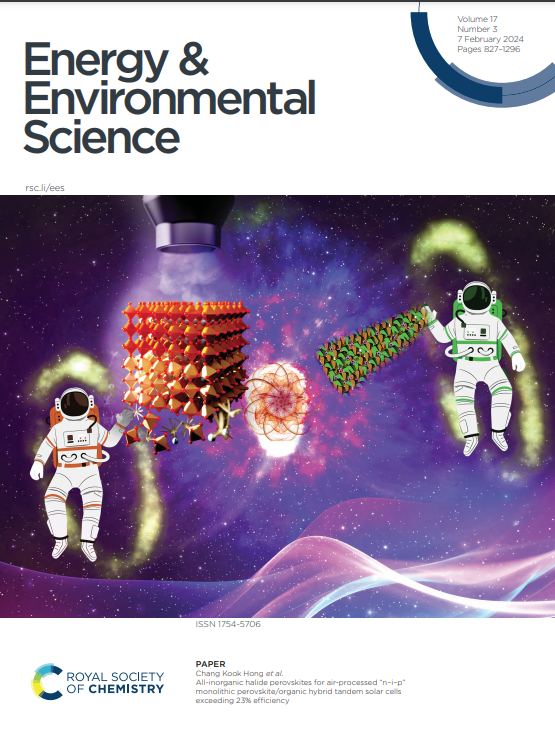Configurational entropy-tailored NASICON cathode redox chemistry for capacity-dense and ultralong cyclability
IF 32.4
1区 材料科学
Q1 CHEMISTRY, MULTIDISCIPLINARY
引用次数: 0
Abstract
Sodium-ion batteries (SIBs) are a promising solution for large-scale energy storage, but their development is hindered by the limited performance of cathode materials. NASICON (Na Superionic Conductor)-type compounds offer fast Na+ diffusion and structural robustness, yet still suffer from low specific capacities (<120 mAh g-1), poor cycling stability, and large volume changes—even after conventional doping. High-entropy (HE) engineering, a strategy that enhances structural and functional stability via multiple equimolar dopants, has shown great promise in layered oxides, but its application in NASICONs has been fundamentally challenging due to rigid polyanionic frameworks, dopant incompatibility, and redox mismatch. Here we report the entropy-stabilized NASICON cathode, Na3.2V1.5Cr0.1Mn0.1Fe0.1Al0.1Mg0.1(PO4)3 (HE-V), synthesized by compositionally complex doping at the 12c Wyckoff site. The HE strategy enables a single-phase material with enhanced redox flexibility and suppressed lattice strain. HE-V delivers a high reversible capacity of 170 mAh g-1, enabled by multi-electron V5+/V4+/V3+/V2+ redox reactions, and demonstrates exceptional rate performance and cycling stability—maintaining performance over 10,000 cycles at 50 C. Operando and ex situ characterizations reveal a nearly zero-strain structure, low defect formation, and enhanced local bonding. Theoretical calculations further confirm bandgap narrowing and improved charge transport. This work establishes a new class of high-entropy polyanionic cathodes, overcoming long-standing limitations in NASICON chemistry and offering a viable path toward durable, high-energy SIBs.配置熵定制的NASICON阴极氧化还原化学,用于容量密集和超长循环
钠离子电池(SIBs)是一种很有前途的大规模储能解决方案,但其发展受到阴极材料性能有限的阻碍。NASICON(钠超离子导体)类型的化合物提供快速的Na+扩散和结构坚固性,但仍然存在低比容量(<120 mAh g-1),较差的循环稳定性和大的体积变化-即使在常规掺杂之后。高熵(HE)工程是一种通过多种等摩尔掺杂剂来增强结构和功能稳定性的策略,在层状氧化物中显示出巨大的前景,但由于刚性的聚阴离子框架、掺杂剂不相容和氧化还原失配,其在NASICONs中的应用一直面临着根本性的挑战。本文报道了在12c Wyckoff位采用复合掺杂法制备了熵稳定的NASICON阴极Na3.2V1.5Cr0.1Mn0.1Fe0.1Al0.1Mg0.1(PO4)3 (HE-V)。HE策略使单相材料具有增强的氧化还原灵活性和抑制晶格应变。通过多电子V5+/V4+/V3+/V2+氧化还原反应,HE-V提供了170 mAh g-1的高可逆容量,并表现出卓越的速率性能和循环稳定性,在50℃下超过10,000次循环保持性能。操作和非原位表征显示几乎零应变结构,低缺陷形成和增强的局部键合。理论计算进一步证实了带隙的缩小和电荷输运的改善。这项工作建立了一类新的高熵聚阴离子阴极,克服了NASICON化学长期存在的局限性,并提供了一条通向耐用、高能sib的可行途径。
本文章由计算机程序翻译,如有差异,请以英文原文为准。
求助全文
约1分钟内获得全文
求助全文
来源期刊

Energy & Environmental Science
化学-工程:化工
CiteScore
50.50
自引率
2.20%
发文量
349
审稿时长
2.2 months
期刊介绍:
Energy & Environmental Science, a peer-reviewed scientific journal, publishes original research and review articles covering interdisciplinary topics in the (bio)chemical and (bio)physical sciences, as well as chemical engineering disciplines. Published monthly by the Royal Society of Chemistry (RSC), a not-for-profit publisher, Energy & Environmental Science is recognized as a leading journal. It boasts an impressive impact factor of 8.500 as of 2009, ranking 8th among 140 journals in the category "Chemistry, Multidisciplinary," second among 71 journals in "Energy & Fuels," second among 128 journals in "Engineering, Chemical," and first among 181 scientific journals in "Environmental Sciences."
Energy & Environmental Science publishes various types of articles, including Research Papers (original scientific work), Review Articles, Perspectives, and Minireviews (feature review-type articles of broad interest), Communications (original scientific work of an urgent nature), Opinions (personal, often speculative viewpoints or hypotheses on current topics), and Analysis Articles (in-depth examination of energy-related issues).
 求助内容:
求助内容: 应助结果提醒方式:
应助结果提醒方式:


